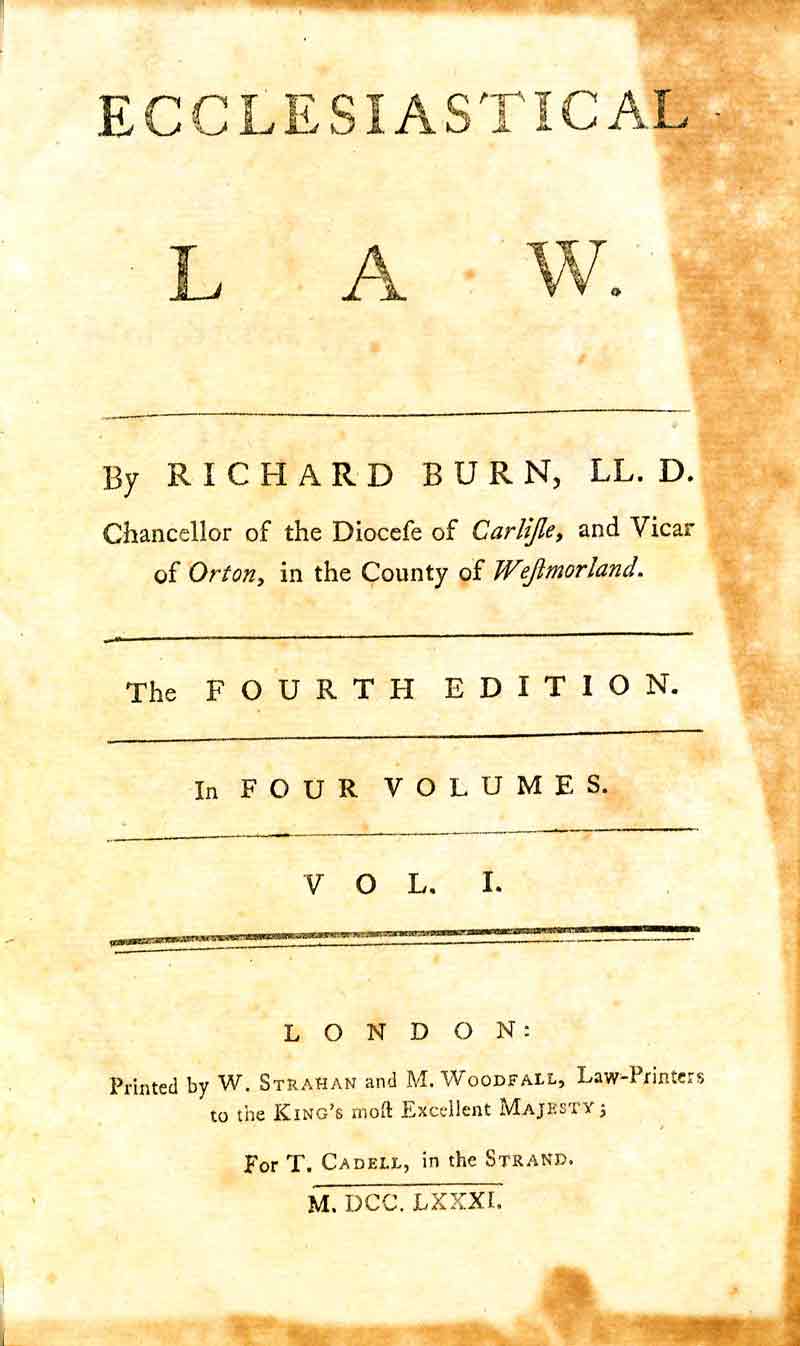Difference between revisions of "Ecclesiastical Law"
| Line 25: | Line 25: | ||
Bound in contemporary calf with tooled edges and banded spines.<br /> | Bound in contemporary calf with tooled edges and banded spines.<br /> | ||
<br /> | <br /> | ||
| − | View this book in [https://catalog.swem.wm.edu/law/Record/3473589 William & Mary's online catalog.] | + | View the record for this book in [https://catalog.swem.wm.edu/law/Record/3473589 William & Mary's online catalog.] |
==References== | ==References== | ||
<references/> | <references/> | ||
Revision as of 14:24, 16 March 2015
by Richard Burn
| Ecclesiastical Law | |
|
Title page from Ecclesiastical Law, volume one, George Wythe Collection, Wolf Law Library, College of William & Mary. | |
| Author | Richard Burn |
| Published | London: Printed by W. Strahan and M. Woodfall, Law-Printers to the King's Most Excellent Majesty for T. Cadell, in the Strand |
| Date | 1781 |
| Edition | Fourth |
| Language | English |
| Volumes | 4 volume set |
| Desc. | 8vo (22 cm.) |
Richard Burn (1709–1785) attended Queen's College, Oxford, and later became a justice of the peace for Westmoreland and Cumberland counties.[1] A clergyman of the Church of England, Burn was appointed Chancellor of the diocese of Carlisle in 1762, a post he held until his death.[2] Burn wrote several books on legal topics. His Justice of the Peace became the standard in its field, passing through fifteen editions in Burn's lifetime.[3]
In Ecclesiastical Law, Burns attempted to categorize and explain elements of ecclesiastical law that had been previously muddy and undefined.[4] It was of equal merit and nearly as popular as his Justice of the Peace. "In the preface the author gives a sketch of the history of the civil and canon law, and short accounts of the position of the ecclesiastical law in England after the Restoration, of the common and statute law, and of that part of the jurisdiction of the court of Chancery which was exercised by it concurrently with the ecclesiastical courts."[5] The ninth and final edition of Ecclesiastical Law was published in 1842.
Evidence for Inclusion in Wythe's Library
Bennie Brown included the fourth edition (1781) of Ecclesiastical Law in his bibliography[6] based on a notation in Thomas Jefferson's manuscript library catalog (1770-1812). Jefferson listed "Burn's Ecclesiastical law. 4.v. 8vo. 4th G. Wythe," the name of Wythe being inscribed in pencil. Whether the copy came from Wythe or was loaned to Wythe is unknown. The Wolf Law Library followed Brown's suggestion and purchased a copy of the fourth edition.
Description of the Wolf Law Library's copy
Bound in contemporary calf with tooled edges and banded spines.
View the record for this book in William & Mary's online catalog.
References
- ↑ Norma Landau, "Burn, Richard (1709–1785)" in Oxford Dictionary of National Biography (Oxford University Press, 2004- ), accessed June 7, 2013.
- ↑ Ibid.
- ↑ William Holdsworth, A History of English Law (London: Methuen & Co., Sweet and Maxwell, 1938), 12:333.
- ↑ Encyclopædia Britannica, s.v. "Burn, Richard" (University of Cambridge, 1911), accessed October 2, 2013.
- ↑ Holdsworth, A History of English Law, 612.
- ↑ Bennie Brown, "The Library of George Wythe of Williamsburg and Richmond," (unpublished manuscript, May, 2012) Microsoft Word file. Earlier edition available at: https://digitalarchive.wm.edu/handle/10288/13433
